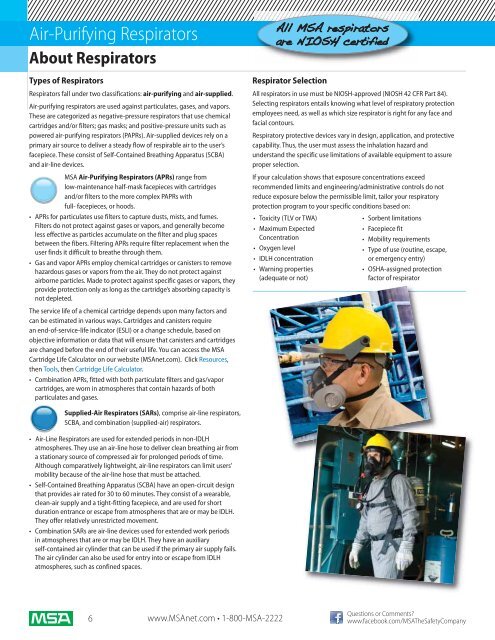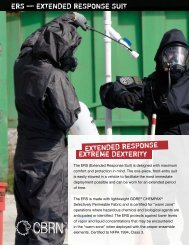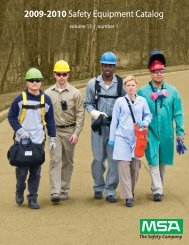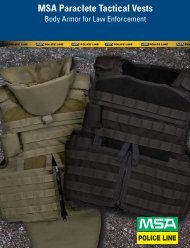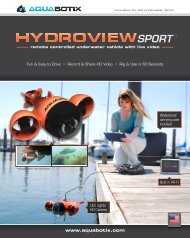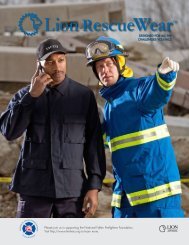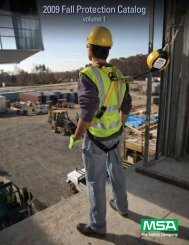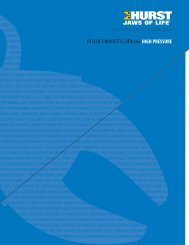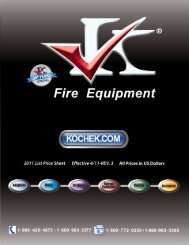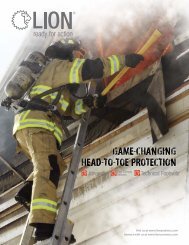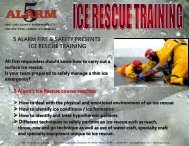Industrial Equipment Catalog - 5 Alarm Fire and Safety Equipment
Industrial Equipment Catalog - 5 Alarm Fire and Safety Equipment
Industrial Equipment Catalog - 5 Alarm Fire and Safety Equipment
- No tags were found...
Create successful ePaper yourself
Turn your PDF publications into a flip-book with our unique Google optimized e-Paper software.
Air-Purifying RespiratorsAbout RespiratorsTypes of RespiratorsRespirators fall under two classifications: air-purifying <strong>and</strong> air-supplied.Air-purifying respirators are used against particulates, gases, <strong>and</strong> vapors.These are categorized as negative-pressure respirators that use chemicalcartridges <strong>and</strong>/or filters; gas masks; <strong>and</strong> positive-pressure units such aspowered air-purifying respirators (PAPRs). Air-supplied devices rely on aprimary air source to deliver a steady flow of respirable air to the user’sfacepiece. These consist of Self-Contained Breathing Apparatus (SCBA)<strong>and</strong> air-line devices.MSA Air-Purifying Respirators (APRs) range fromlow-maintenance half-mask facepieces with cartridges<strong>and</strong>/or filters to the more complex PAPRs withfull- facepieces, or hoods.• APRs for particulates use filters to capture dusts, mists, <strong>and</strong> fumes.Filters do not protect against gases or vapors, <strong>and</strong> generally becomeless effective as particles accumulate on the filter <strong>and</strong> plug spacesbetween the fibers. Filtering APRs require filter replacement when theuser finds it difficult to breathe through them.• Gas <strong>and</strong> vapor APRs employ chemical cartridges or canisters to removehazardous gases or vapors from the air. They do not protect againstairborne particles. Made to protect against specific gases or vapors, theyprovide protection only as long as the cartridge’s absorbing capacity isnot depleted.The service life of a chemical cartridge depends upon many factors <strong>and</strong>can be estimated in various ways. Cartridges <strong>and</strong> canisters requirean end-of-service-life indicator (ESLI) or a change schedule, based onobjective information or data that will ensure that canisters <strong>and</strong> cartridgesare changed before the end of their useful life. You can access the MSACartridge Life Calculator on our website (MSAnet.com). Click Resources,then Tools, then Cartridge Life Calculator.• Combination APRs, fitted with both particulate filters <strong>and</strong> gas/vaporcartridges, are worn in atmospheres that contain hazards of bothparticulates <strong>and</strong> gases.Respirator SelectionAll respirators in use must be NIOSH-approved (NIOSH 42 CFR Part 84).Selecting respirators entails knowing what level of respiratory protectionemployees need, as well as which size respirator is right for any face <strong>and</strong>facial contours.Respiratory protective devices vary in design, application, <strong>and</strong> protectivecapability. Thus, the user must assess the inhalation hazard <strong>and</strong>underst<strong>and</strong> the specific use limitations of available equipment to assureproper selection.If your calculation shows that exposure concentrations exceedrecommended limits <strong>and</strong> engineering/administrative controls do notreduce exposure below the permissible limit, tailor your respiratoryprotection program to your specific conditions based on:• Toxicity (TLV or TWA)• Maximum ExpectedConcentration• Oxygen level• IDLH concentration• Warning properties(adequate or not)• Sorbent limitations• Facepiece fit• Mobility requirements• Type of use (routine, escape,or emergency entry)• OSHA-assigned protectionfactor of respiratorSupplied-Air Respirators (SARs), comprise air-line respirators,SCBA, <strong>and</strong> combination (supplied-air) respirators.• Air-Line Respirators are used for extended periods in non-IDLHatmospheres. They use an air-line hose to deliver clean breathing air froma stationary source of compressed air for prolonged periods of time.Although comparatively lightweight, air-line respirators can limit users’mobility because of the air-line hose that must be attached.• Self-Contained Breathing Apparatus (SCBA) have an open-circuit designthat provides air rated for 30 to 60 minutes. They consist of a wearable,clean-air supply <strong>and</strong> a tight-fitting facepiece, <strong>and</strong> are used for shortduration entrance or escape from atmospheres that are or may be IDLH.They offer relatively unrestricted movement.• Combination SARs are air-line devices used for extended work periodsin atmospheres that are or may be IDLH. They have an auxiliaryself-contained air cylinder that can be used if the primary air supply fails.The air cylinder can also be used for entry into or escape from IDLHatmospheres, such as confined spaces.6www.MSAnet.com • 1-800-MSA-2222Questions or Comments?www.facebook.com/MSAThe<strong>Safety</strong>Company


